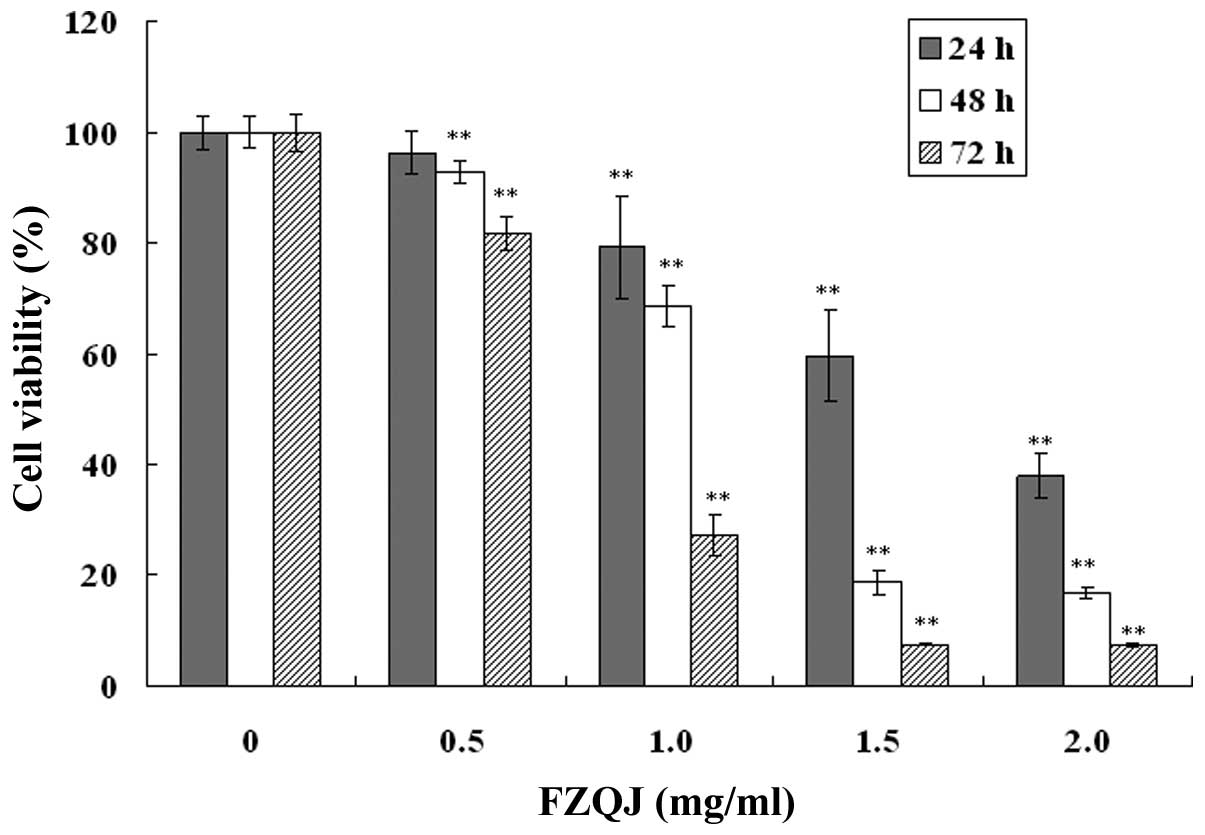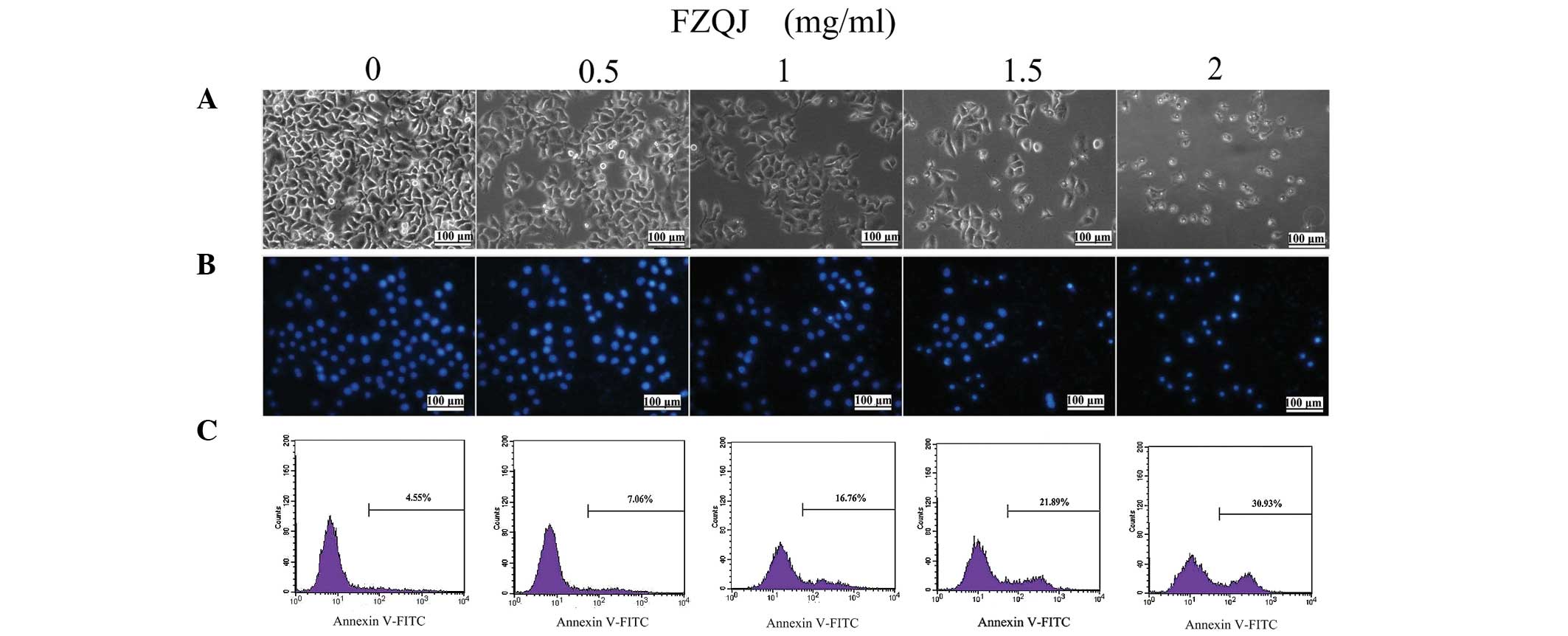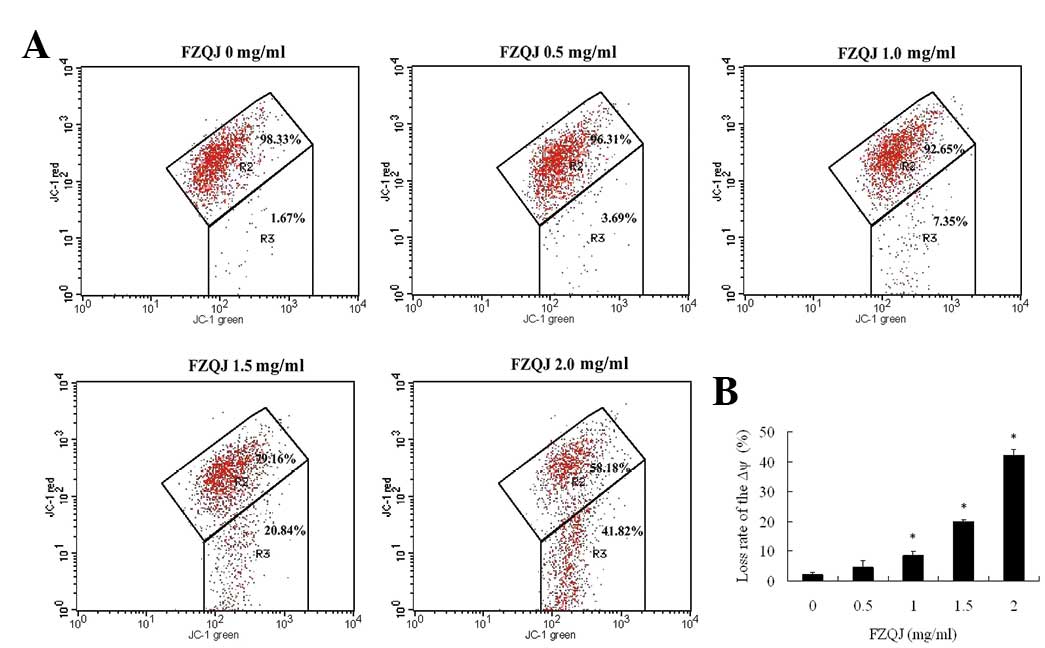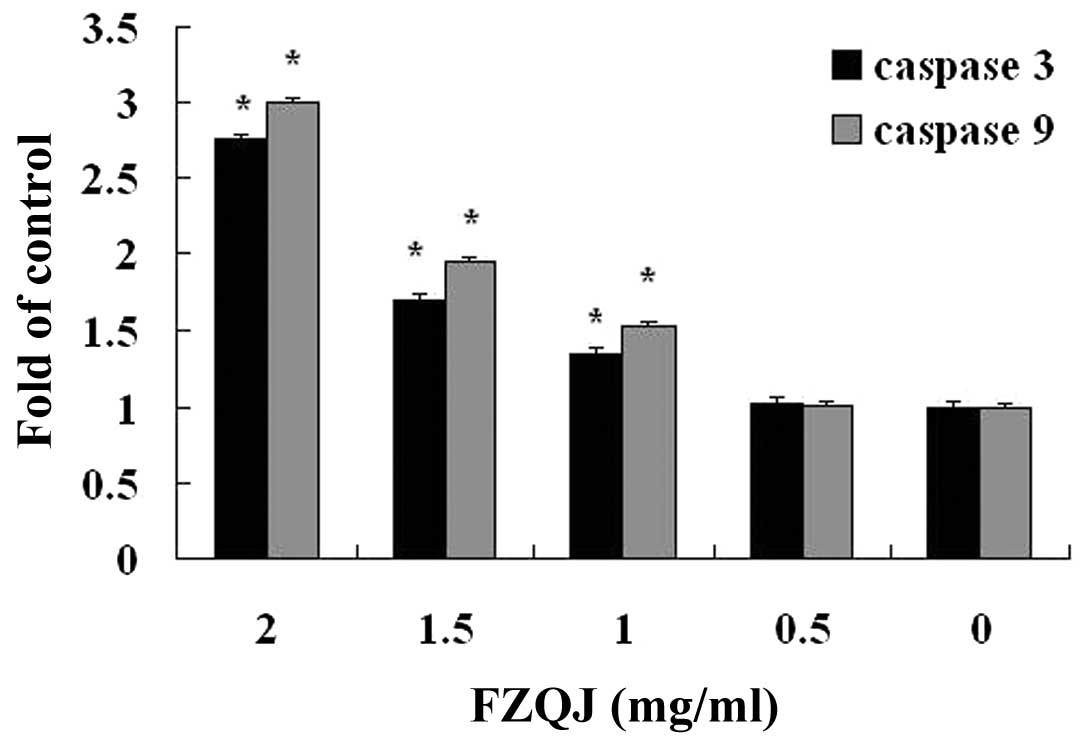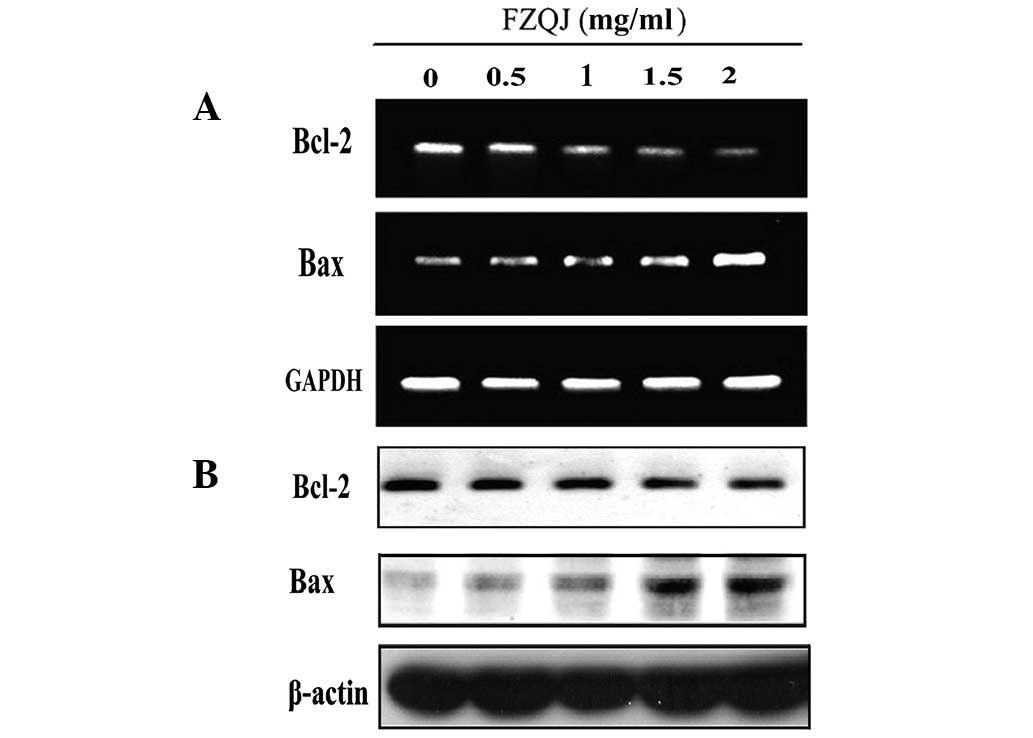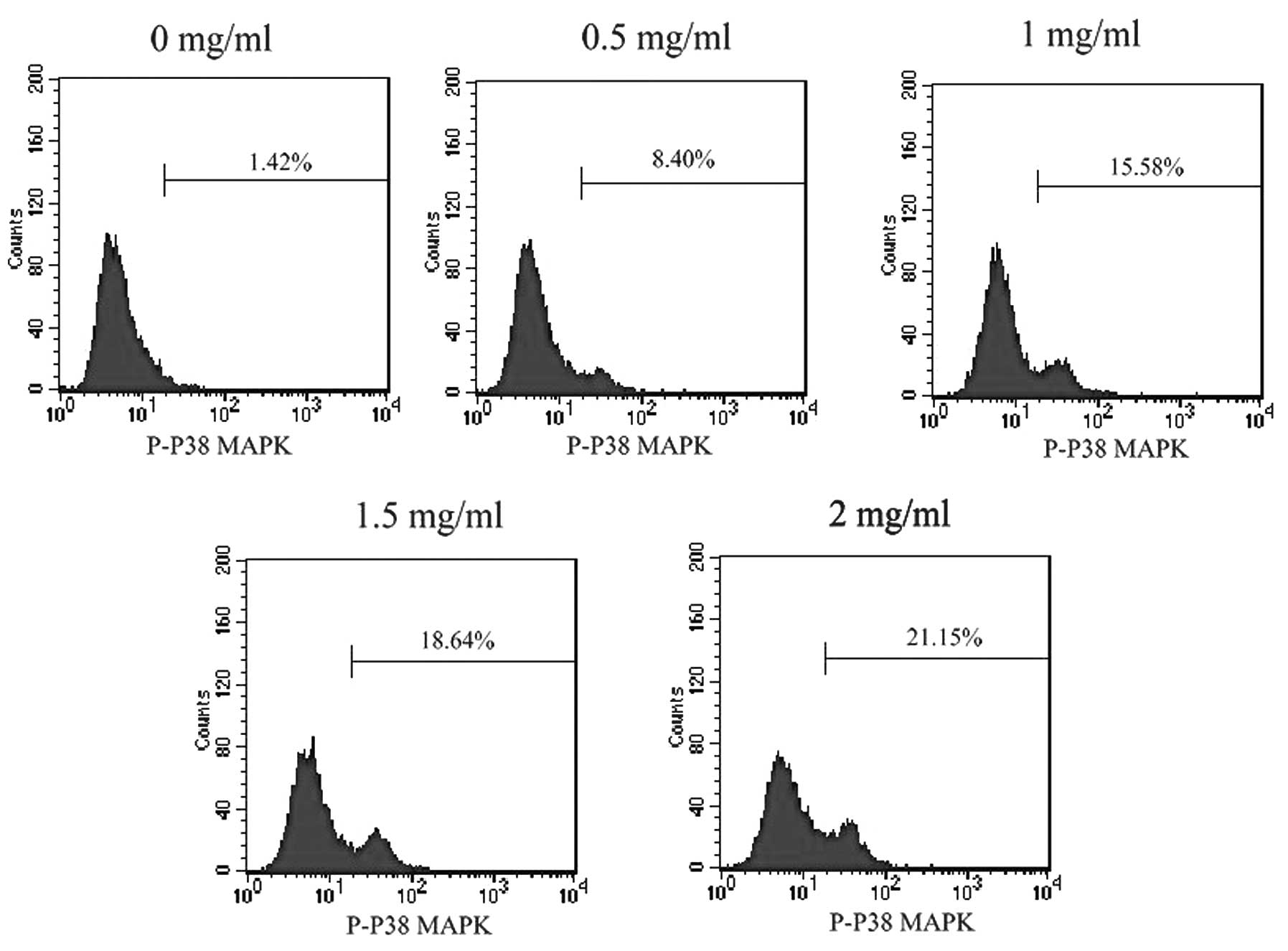Fuzheng Qingjie recipe induces apoptosis in HepG2 cells via P38 MAPK activation and the mitochondria-dependent apoptotic pathway
- Authors:
- Published online on: April 11, 2014 https://doi.org/10.3892/mmr.2014.2138
- Pages: 2381-2387
Abstract
Introduction
Due to latent onset, rapid progression and poor prognosis, hepatocellular carcinoma (HCC) is the third-leading cause of cancer-related mortality worldwide, particularly in Africa and Asia (1,2). Despite the continuous introduction of numerous new treatments, the overall five-year survival rate remains low (3,4). As the majority of patients are in the advanced stages and have metastasis when they are diagnosed with HCC, they are not referred for surgical resection, liver transplantation or radiofrequency ablation. These patients are only able to be treated with chemotherapy and/or radiotherapy in addition to palliative care. However, the development of cancer cell resistance and severe side effects represent main obstacles to the success of chemoradiotherapy. It is thus urgent to develop new therapeutics with lower toxicity and higher efficiency, or new adjuvant therapies that are able to improve the efficiency or decrease the side effects of the current chemoradiotherapy to improve patient survival and quality of life. Traditional Chinese medicine (TCM) may be a promising candidate.
In accordance with the TCM principle, cancer occurs when Xie is stronger than Zheng in the human body. Xie refers to various pathogenic factors (including viruses, fungi and bacteria). Zheng means the disease-fighting ability of the body, including immune function. Fuzheng (improving Zheng) Quxie (eradicating Xie) is thus the basic theory of fighting cancer in TCM. The clinical manifestations of Zheng deficiency include weakness, night sweating, dizziness, pallor, shortness of breath and anemia. Zheng deficiency is common in patients following chemotherapy and/or radiotherapy. These patients often present with symptoms of Xie, including ache, hyperpyrexia, restlessness and a quick pulse rate. Clearly, Zheng deficiency and Xie often coexist in patients with malignancy. Therefore, doctors of TCM always prescribe Fuzheng herbs and Quxie herbs together for cancer patients.
Fuzheng recipes are able to supplement the vital energy, tonify kidney and nourish yin, including Ginseng and Ganoderma. In clinical trials and basic experiments, these herbs are found to possess the ability to modulate immunity, enhance the efficiency of chemoradiotherapy and improve the quality of life of patients (5–8). Quxie herbs are capable of heat-clearing and detoxification, including Hedyotis Diffusa Willd and Prunella vulgaris. Pharmacological studies have demonstrated that they contain ingredients that directly induce cancer cell apoptosis, suppress angiogenesis as well as cell invasion and migration (9–12). The combination of Fuzheng and Quxie herbs are not only able to improve the efficiency but also alleviate the adverse effect of chemoradiotherapy.
Fuzheng Qingjie (FZQJ) recipe is a polyherbal formula of Fuzheng and Quxie herbs, which includes Astragalus membranaceus, Ligustrum lucidum, Ganoderma lucidum, Rhizoma dioscorea, Hedyotis Diffusa Willd and Prunella vulgaris (13). The first four are Fuzheng herbs and the other two are Quxie herbs. They have been used for a long time as adjuvant treatments for gastrointestinal malignancies with proven clinical efficacy. Previously, we used an apoptosis microarray (Spring Bioscience, Pleasanton, CA, USA) to screen the pharmacological targets of FZQJ recipe in cancer cells and identified that FZQJ could regulate numerous apoptosis-related genes, including Bax, caspase-3 and -9 and P38 mitogen-activated protein kinase (MAPK; unpublished data). Since the activation of P38 MAPK can result in mitochondria-dependent apoptosis, we investigated whether the activation of P38 MAPK is involved in the apoptotic cell death induced by FZQJ.
Materials and methods
Preparation of water extract of FZQJ herbs
Herbs were purchased from Tongchun Pharmaceutical Co., Ltd (Fuzhou, Fujian, China). Their quality met the criteria described in the Pharmacopoeia of the People’s Republic of China. To prepare water extract, Astragalus membranaceus (60 g), Ligustrum lucidum (60 g), Ganoderma lucidum (30 g), Rhizoma dioscorea (30 g), Prunellae vulgaris (30 g) and Hedyotis diffusa Willd (60 g) were pulverized into extremely fine powders with a mortar and pestle and immersed in distilled water, respectively. The mixture was simmered for 2 h and filtered. The solution was concentrated so that it contained 2.66 g of dry herbs per 1 ml and was stored at 4°C until use.
Cell culture
Human HepG2 hepatoma cells were purchased from the Shanghai Institute of Life Science, Chinese Academy of Sciences (Shanghai, China). Cells were maintained in RPMI-1640 culture medium (Gibco-BRL, Carlsbad, CA, USA) with 100 ml/l of fetal calf serum, 1×105 U/l of penicillin and 100 mg/l of streptomycin (Gibco-BRL) in an incubator (Thermo Fisher Scientific, Rockford, IL, USA) at 37°C with 5% CO2. Cell morphology was observed using an inverted microscope (Olympus, Tokyo, Japan).
MTT assay
Cells were cultured in the absence or presence of water extract of FZQJ at the final concentrations of 0.5, 1, 1.5 and 2 mg/ml for 24, 48 and 72 h respectively. Then, 20 μl of 5 mg/ml 3-(4,5-dimethylthiazol-2-yl)-2,5-diphenyltetrazolium bromide (MTT; Invitrogen Life Technologies, Carlsbad, CA, USA) was added to each well and incubated for another 4 h prior to discarding the medium. The purple-blue formazan precipitate was dissolved in 100 μl of dimethyl sulfoxide (DMSO). The absorbance (OD) was measured at 490 nm with a microplate reader (BioTek Instruments Inc., Winooski, VT, USA). The cell viability ratio was calculated according to the following formula: Cell viability ratio (%) = average ODtreatment group/average ODvehicle group × 100%.
DAPI staining
In brief, following treatment with different concentrations of water extract of FZQJ for 24 h, the cells were fixed with 4% paraformaldehyde and then incubated with 1 μg/ml of 4,6-diamidino-2-phenylindole (DAPI) staining solution (Beyotime Inc., Shanghai, China) at room temperature for 5 min and washed with PBS 3 times. The morphology of nuclei in HepG2 cells was observed under a fluorescence microscope (Olympus) at an excitation wavelength of 350 nm.
Cell apoptosis and mitochondrial membrane potential assays
Cells were incubated in 6-well plates for 24 h in the absence or presence of different concentrations of FZQJ water extract. Then cells were digested by trypsinase and washed twice with cold PBS. A final concentration of 1×106 cells/ml of single-cell suspension was prepared. Apoptosis and mitochondrial membrane potential (Δψ) were measured by a flow cytometer (BD Biosciences, Franklin Lakes, NJ, USA) with Annexin-V fluorescein isothiocyanate (FITC) or 5,5′,6,6′-tetrachloro-1,1′,3,3′-tetraethylbenzimidazolcarbocyanine iodide (JC-1; BD Biosciences). Cells (10,000) were acquired and analyzed using CellQuest software (BD Biosciences). Each determination was performed as three parallel assays.
Reverse transcription polymerase chain reaction (RT-PCR)
Total cellular RNA was isolated using the TRIzol one-step method according to the manufacturer’s instructions (Invitrogen Life Technologies). Single-stranded cDNA was synthesized using oligo (dT) primer (Takara, Dalian, China) in a 20 μl reaction mixture. Bcl-2 and Bax mRNA were evaluated using PCR. The primer pairs of Bcl-2, Bax and GAPDH were as follows: Bcl-2, forward 5′-CAG CTG CAC CTG ACG CCC TT-3′ and reverse 5′-GCC TCC GTT ATC CTG GAT CC-3′; Bax, forward 5′-TGC TTC AGG GTT TCA TCC AGG-3′ and reverse 5′-TGG CAA AGT AGA AAA GGG CGA-3′; GAPDH, forward 5′-AGA AGG CTG GGG CTC ATT TG-3′ and reverse 5′-AGG GGC CAT CCA CAG TCT TC-3′. DNA amplification was performed for 40 cycles following an initial denaturation step at 94°C for 5 min in a thermo cycler by using the following program: denaturation at 94°C for 30 sec, annealing at 58°C for 30 sec, extension at 72°C for 30 sec and a final extension at 72°C for 10 min. PCR reagent kit was obtained from Takara. Finally, the amplified products were separated on a 1.2% agarose gel and examined using a Gel Doc 2000 Imaging System (Bio-Rad, Hercules, CA, USA).
Western blot analysis
HepG2 cells were collected and lysed in lysis buffer (Beyotime Inc.) for 10 min following treatment with different concentrations of FZQJ water extract for 24 h. Following centrifugation at 12,000 × g at 4°C for 20 min, the supernatant was collected and the protein concentration determined using the Bradford assay. Equal amounts of denatured protein were separated on SDS-PAGE gels and transferred onto PVDF membranes. These membranes were then put into blocking solution for 1 h and incubated in solution with either monoclonal anti-human Bax or Bcl-2 primary antibody (Santa Cruz Biotechnology, Inc., Santa Cruz, CA, USA) overnight at 4°C with agitation and then in horseradish peroxidase (HRP)-conjugated secondary antibody (Beyotime Inc.) for at least 1 h. Protein was detected with ECL solution (Beyotime Inc.) using a chemiluminescence imaging system (Bio-Rad).
Caspase-3 and -9 activation analysis
The activities of caspase-3 and -9 were examined using caspase-3 and -9 colorimetric assay kits (KeyGen Biotech, Nanjing, Jiangsu, China). Briefly, HepG2 cells were collected and lysed on ice with 100 μl of lysis buffer (containing 1% dithiothreitol) following treatment with different concentrations of FZQJ water extract for 24 h. Following centrifugation at 11,000 × g for 1 min, the protein concentration of the supernatant was determined using the Bradford assay. Equal amounts of protein were incubated with specific substrates of caspase-3 or -9 at 37°C in the dark for 4 h. Finally the samples were determined at 405 nm by a microplate reader (BioTek Instruments Inc.). The activities of caspase -3 or -9 were calculated according to the formula: average ODtreatment/average ODvehicle.
Phosphorylated P38 MAPK assay
Phosphorylated P38 MAPK (p-P38 MAPK) was evaluated using flow cytometry. The cells were digested and rinsed with PBS following treatment with different concentrations of FZQJ water extract for 48 h. Then cells were suspended, fixed with fixation buffer for 10 min at 37°C, permeabilized on ice for 30 min and stained with Alexa Fluor® 647 mouse anti-p-P38 MAPK antibody (BD Biosciences). The cells were analyzed with the flow cytometer.
Statistical analysis
Data were analyzed using the SPSS 16.0 statistical package. All results are expressed as the mean ± standard deviation (SD) of at least three experiments. The data for multiple comparisons were performed by one-way ANOVA. P<0.05 was considered to indicate a statistically significant difference.
Results
Water extract of FZQJ recipe inhibits HepG2 cell proliferation
FZQJ made according to the patent (13). The growth of HepG2 cells was evaluated using an MTT assay. As shown in Fig. 1, in the presence of indicated concentrations of water extracts, cell proliferation was inhibited in a dose- and time-dependent manner. The inhibitory rate of HepG2 cells was able to reach as high as 92.57% at the highest concentration for 72 h. The results demonstrated that water extract of FZQJ markedly inhibited the proliferation of HepG2 cells.
Water extract of FZQJ induces apoptosis of HepG2 cells
We first evaluated apoptosis of HepG2 cells treated with indicated doses of FZQJ for 24 h through observing the morphological changes using an inverted fluorescence microscope. As shown in Fig. 2A, a decreased cell number was associated with morphological changes of cells following the addition of FZQJ to the medium; polygon- or spindle-shaped cells became round, shrunk and collapsed. Following staining of the nuclei with DAPI (a fluorescent DNA-binding agent), more brightened nuclei were observed in the FZQJ-treated cells, with chromatin pyknosis and fragmentation (Fig. 2B). Clearly, FZQJ water extract induced marked apoptotic morphological alterations.
Next, cells were evaluated flow cytometrically by Annexin-V staining. Annexin-V is a cellular protein used as a probe to detect cells that have expressed phosphatidylserine on the cell surface (an event identified in apoptosis). Therefore, Annexin-V positive cells are considered to be apoptotic cells. As displayed in Fig. 2C, the percentage of apoptotic cells stained with Annexin V markedly increased in FZQJ-treated cells in a dose-dependent manner. Taken together, these data revealed that FZQJ extract induced apoptosis of HepG2 cells.
Water extract of FZQJ induces a decrease in the mitochondrial membrane potential
Apoptosis is often accompanied by a decrease of Δψ. Loss of Δψ is important in the early apoptotic process (14). JC-1 is a lipophilic fluorochrome that is found to be sensitive to Δψ and is used as an indicator of Δψ during apoptosis. JC-1 has two different formations, aggregates and monomers. In normal cells with a polarized Δψ, JC-1 aggregates stay in the mitochondria and emit red fluorescence (red channel) and monomers stay in the cytoplasm and exhibit green fluorescence (green channel). Therefore, JC-1-treated normal cells demonstrate green and red channels on flow cytometers. When the mitochondria Δψ depolarizes, JC-1 does not form aggregates in the mitochondria but remains as monomers in the cytoplasm, resulting in increased numbers of cells with reduced JC-1 fluorescence in the red channel. As shown in Fig. 3, JC-1 fluorescence was observed in red and green channels (R2 region) in the vehicle-treated cells, indicating that the majority of cells were alive. In the presence of increasing concentrations of FZQJ, there was a significant increase in the number of cells with lowered red fluorescence (R3 region), indicative of a depolarized Δψ. Thus, the data indicate that FZQJ-induced apoptosis was associated with the depolarization of Δψ.
Water extract of FZQJ induces activation of caspase-3 and-9 in HepG2 cells
The activities of caspase-3 and -9 are closely associated with the mitochondria-dependent apoptosis pathway. We next examined whether caspase-3 and -9 were involved in FZQJ-induced depolarization of Δψ in HepG2 cells. The activities of caspase-3 and -9 were examined by colorimetric assay. The results demonstrated that the activities of caspase-3 and -9 were markedly increased in a dose-dependent manner. Following treatment with 2 mg/ml of FZQJ extract for 24 h, 2.77-fold and 2.99-fold increases were observed for caspase-3 and -9 activity compared with the vehicle control, respectively (Fig. 4). The data suggested that water extract of FZQJ could decease Δψ in HepG2 cells via the activation of caspase-3 and -9.
Water extract of FZQJ downregulates Bcl-2 and upregulates Bax
Antiapoptotic Bcl-2 and proapoptotic Bax are members of the Bcl-2 family and are critical in apoptosis controlled by mitochondria. To further investigate how FZQJ induces mitochondria-dependent apoptosis, the expression of Bcl-2 and Bax were evaluated in mRNA and protein levels by RT-PCR and western blot analysis, respectively. As shown in Fig. 5A, compared with the vehicle control, FZQJ decreased Bcl-2 mRNA and increased Bax mRNA expression in a dose-dependent manner. Similar results were observed in western blot analyses (Fig. 5B), indicating that FZQJ induced depolarization of Δψ in HepG2 cells through regulating the expression of members of the Bcl-2 family.
Water extract of FZQJ activates P38 MAPK
Activation of P38 MAPK has been demonstrated to lead to cell death via stimulating mitochondrial Bax translocation and activating caspase -9 and -3 (15). To investigate whether FZQJ induces mitochondrial apoptosis via activation of P38 MAPK, phosphorylation of P38 MAPK was evaluated. As shown in Fig. 6, FZQJ treatment caused a dose-dependent increase of p-P38 MAPK level in HepG2 cells, indicating that FZQJ could activate P38 MAPK.
Discussion
In previous years, TCMs have been used in an increasing number of countries to treat tumors and the underlying mechanisms are being investigated (16,17). TCMs are drawing more and more attention from oncologists as, in addition to direct inhibition on tumor growth, TCMs may improve the anticancer response and reduce the side effects of chemotherapy. Moreover, TCMs have few and mild adverse effects (18,19).
FZQJ recipe has been prescribed to treat cancer and manage the side effects of chemotherapy in China. It is composed of six medinical herbs. Our previous study demonstrated that these 6 herbs are commonly prescribed for patients with malignant tumors according to cluster analysis (20). These herbs contain compounds with anticancer activities, including polysaccharides, saponins, flavones, anthraquinones and polyphenols. By molecular docking simulation, we revealed that Bcl-xl, tumor necrosis factor (TNF)-α, interleukin (IL)-2, and cyclooxygenase 2 are possible targets of Hedyotis diffusa Willd and Prunella vulgaris in the FZQJ recipe (21). Pharmacological studies have demonstrated that compounds in herbs of FZQJ recipe can inhibit the proliferation of tumor cells, induce apoptosis of tumor cells, improve the sensitivity of cancer cells to chemotherapy and modulate immune function. For instance, Astragalus polysaccharides were demonstrated to enhance the chemosensitivity of H22 hepatoma cells resistant to adriamycin (22). Astragalus polysaccharides can inhibit the proliferation of the basal-like breast cancer cell line MDA-MB-468 via regulating p53/MDM2 positive and negative feedback loops (23). 2-Hydroxy-3-methylanthraquinone from Hedyotis diffusa Willd was revealed to be able to induce apoptosis in different tumor cells through the modulation of MAPK pathways (24), the Ca2+/calpain/caspase-4 pathway (25), as well as the alteration of Fas/FasL and the activation of caspase-8 (26). Ganoderma lucidum polysaccharides can enhance immunity via reducing the levels of serum IL-6 and TNF-α and increasing those of serum IL-2, IL-4 and IL-10 (27). Oleanolic acid from Prunella Vulgaris was demonstrated to induce apoptosis of lung adenocarcinoma cells through downregulating Bcl-2 expression and upregulating Bax and Bad expression (28). An oleanolic acid-enriched extract of Ligustrum Lucidum were found to have potential immunomodulatory effects through enhancing the proliferative activity of blood lymphocytes and upregulating the CD4+CD8+ and CD4+CD8− cell populations as well as regulating the expression of Th1- and Th2-related cytokines (29). In addition, a polysaccharide from Dioscorea opposita Thunb roots was demonstrated to be able to enhance the immunological activity via stimulating ConA-induced T lymphocyte proliferation (30). Thus, it is possible the recipe containing these herbs according to the TCM theory may have additive anticancer effects.
Cysteine aspartyl-specific proteases (caspases), a family of cysteine proteases, act in concert in a cascade-triggered manner and are activated via three main pathways when cells receive apoptotic signals (31). The three pathways are death receptors signaling, the mitochondrial pathway and the endoplasmic reticulum stress pathway. The second pathway is an intrinsic pathway, in which mitochondria are the central organelle governed by pro- and anti-apoptotic members of the Bcl-2 family (32). Numerous molecules in mitochondria are found to be closely associated with cell apoptosis, including cytochrome c (cyt-c), apoptosis-inducing factor and reactive oxygen species (33). When a mitochondrion is damaged, mitochondrial outer membrane permeabilization occurs and Δψ collapse. Then cyt-c is released from the mitochondrial intermembrane space into the cytoplasm. Subsequently, cyt-c couples with apoptosis protease activating factor-1 and triggers pro-caspase-9 assembly to promote production of active caspase-9 (34,35). Active caspase-9 further activates the downstream proteases of the caspase cascade, including caspase-3, -6 and -7 (36). These proteases may lead to DNA mismatch repair dysfunction, and even fragmentation, finally causing inevitable apoptotic cell death (37). Caspase-3 and -9 are key proteases responsible for the execution of apoptosis.
The mitochondria-dependent cell death cascade is regulated by the Bcl-2 family. The members of the Bcl-2 family include anti-apoptotic (Bcl-2) and pro-apoptotic members (Bax). Bax can promote the openness of mitochondrial permeability transition pores (MPTP) and release cyt-c, subsequently activating the caspase cascade and triggering apoptosis. Inversely, Bcl-2 can inhibit the openness of MPTP and protect cells from apoptosis. Previous studies have provided evidence that overexpression of the Bcl-2 protein or decreased expression of the Bax gene was associated with poor prognosis in various diseases (38). In the present study, we demonstrated that FZQJ may downregulate Bcl-2 expression and upregulate Bax expression and activate caspase-3 and -9, indicating that FZQJ-induced apoptosis of HepG2 cells is at least through the mitochondria-dependent apoptotic cascade.
P38 MAPK is a member of the MAPK family. It is crucial in regulating cellular proliferation, differentiation and apoptosis (39–41). The upregulation of P38 MAPK activity is essential for apoptotic induction in tumor cells. Apoptosis mediated by Fas/Fas-ligand (42), c-myc (43), p53 (44) as well as c-jun and c-jos (41) are associated with the enhanced activation of p38 MAPK. In addition, numerous studies also demonstrated that P38 MAPK activity could activate the mitochondria-dependent cell death pathway by stimulating Bax translocation from the cytosol to the mitochondria, further promoting the release of cyt-c and thereby triggering the cell death cascade (45,46,15). Our findings demonstrated that water extract of FZQJ could activate P38 MAPK, which may be responsible for the activation of the mitochondria-dependent cell death cascade.
In conclusion, our results demonstrate that the anti-cancer effect of FZQJ recipe on HepG2 cells may involve the activation of P38 MAPK and the subsequent mitochondria-dependent apoptotic cascade. These data provide scientific basis for the clinical application of FZQJ recipe as an adjunct for chemoradiotherapy.
Acknowledgements
This study was supported by the National Natural Science Foundation of China (no. 81102582) and the Natural Science Foundation of Fujian Province (no. 2013J01379).
Abbreviations:
|
TCM |
traditional chinese medicine |
|
HCC |
hepatocellular carcinoma |
|
FZQJ |
Fuzheng Qingjie |
|
MAPK |
mitogen-activated protein kinase |
|
DAPI |
4,6-diamidino-2-phenylindole |
|
DMSO |
dimethyl sulfoxide |
|
MTT |
3-(4,5-dimethylthiazol-2-yl)-2,5-diphenyltetrazolium bromide |
|
RT-PCR |
reverse transcription polymerase chain reaction |
|
Δψ |
mitochondrial membrane potential |
|
JC-1 |
5,5′,6,6′-tetrachloro-1,1′,3,3′-tetraethylbenzimidazolcarbocyanine iodide |
|
caspase |
cysteine aspartyl-specific protease |
|
HRP |
horseradish peroxidase |
References
|
Rampone B, Schiavone B, Martino A, Viviano C and Confuorto G: Current management strategy of hepatocellular carcinoma. World J Gastroenterol. 15:3210–3216. 2009. View Article : Google Scholar : PubMed/NCBI | |
|
Chung YH, Song IH, Song BC, Lee GC, Koh MS, Yoon HK, Lee YS, Sung KB and Suh DJ: Combined therapy consisting of intraarterial cisplatin infusion and systemic interferon-alpha for hepatocellular carcinoma patients with major portal vein thrombosis or distant metastasis. Cancer. 88:1986–1991. 2000. View Article : Google Scholar | |
|
Mazzaferro V, Regalia E, Doci R, Andreola S, Pulvirenti A, Bozzetti F, Montalto F, Ammatuna M, Morabito A and Gennari L: Liver transplantation for the treatment of small hepatocellular carcinomas in patients with cirrhosis. N Engl J Med. 334:693–699. 1996. View Article : Google Scholar : PubMed/NCBI | |
|
Urruticoechea A, Alemany R, Balart J, Villanueva A, Viñals F and Capellá G: Recent advances in cancer therapy: an overview. Curr Pharm Des. 16:3–10. 2010. View Article : Google Scholar | |
|
Kang S and Min H: Ginseng, the ‘Immunity Boost’: The Effects of Panax ginseng on Immune System. J Ginseng Res. 36:354–368. 2012. | |
|
Choi J, Kim TH, Choi TY and Lee MS: Ginseng for health care: a systematic review of randomized controlled trials in Korean literature. PLoS One. 8:e599782013. View Article : Google Scholar : PubMed/NCBI | |
|
Chang YH, Yang JS, Yang JL, Wu CL, Chang SJ, Lu KW, Kuo CL, Hsia TC and Chung JG: Gandoderma lucidum extract promotes immune responses in normal BALB/c mice in vivo. In Vivo. 23:755–759. 2009.PubMed/NCBI | |
|
Bao PP, Lu W, Cui Y, Zheng Y, Gu K, Chen Z, Zheng W and Shu XO: Ginseng and Ganoderma lucidum use after breast cancer diagnosis and quality of life: a report from the Shanghai Breast Cancer Survival Study. PloS One. 7:e393432012. View Article : Google Scholar : PubMed/NCBI | |
|
Shi Y, Wang CH and Gong XG: Apoptosis-inducing effects of two anthraquinones from Hedyotis diffusa WILLD. Biol Pharm Bull. 31:1075–1078. 2008. View Article : Google Scholar : PubMed/NCBI | |
|
Lin J, Wei L, Shen A, Cai Q, Xu W, Li H, Zhan Y, Hong Z and Peng J: Hedyotis diffusa Willd extract suppresses Sonic hedgehog signaling leading to the inhibition of colorectal cancer angiogenesis. Int J Oncol. 42:651–656. 2013. View Article : Google Scholar | |
|
Kim SH, Huang CY, Tsai CY, Lu SY, Chiu CC and Fang K: The aqueous extract of Prunella vulgaris suppresses cell invasion and migration in human liver cancer cells by attenuating matrix metalloproteinases. Am J Chin Med. 40:643–656. 2012. View Article : Google Scholar : PubMed/NCBI | |
|
Chen XZ, Cao ZY, Chen TS, Zhang YQ, Liu ZZ, Su YT, Liao LM and Du J: Water extract of Hedyotis Diffusa Willd suppresses proliferation of human HepG2 cells and potentiates the anticancer efficacy of low-dose 5-fluorouracil by inhibiting the CDK2-E2F1 pathway. Oncol Rep. 28:742–748. 2012. | |
|
Cai Jing, Cao Zhiyun, Chen Liwu, Chen Xuzheng, Du Jian and Liu Zhizhen: Traditional Chinese medicine for treating tumor of digestive tract, strengthening body, resistance and removing summer-heat. CN Patent 201010130786. Filed March 23, 2010; issued August 4, 2010. | |
|
Jeong SY and Seol DW: The role of mitochondria in apoptosis. BMB Rep. 41:11–22. 2008. View Article : Google Scholar | |
|
Ghatan S, Larner S, Kinoshita Y, Hetman M, Patel L, Xia Z, Youle RJ and Morrison RS: p38 MAP kinase mediates bax translocation in nitric oxide-induced apoptosis in neurons. J Cell Biol. 150:335–347. 2000. View Article : Google Scholar : PubMed/NCBI | |
|
Ernst E and Cassileth BR: The prevalence of complementary/alternative medicine in cancer: a systematic review. Cancer. 83:777–782. 1998. View Article : Google Scholar : PubMed/NCBI | |
|
Boon H, Brown JB, Gavin A, Kennard MA and Stewart M: Breast cancer survivors’ perceptions of complementary/alternative medicine (CAM): making the decision to use or not to use. Qual Health Res. 9:639–653. 1999. | |
|
Konkimalla VB and Efferth T: Evidence-based Chinese medicine for cancer therapy. J Ethnopharmacol. 116:207–210. 2008. View Article : Google Scholar : PubMed/NCBI | |
|
Posadzki P, Watson LK and Ernst E: Adverse effects of herbal medicines: an overview of systematic reviews. Clin Med. 13:7–12. 2013. View Article : Google Scholar : PubMed/NCBI | |
|
Liu Z, Chen S, Cai J, Zhang E, Lan L, Zheng J, Liao L, Yang X, Zhou C and Du J: Traditional Chinese medicine syndrome-related herbal prescriptions in treatment of malignant tumors. J Tradit Chin Med. 33:19–26. 2013. View Article : Google Scholar : PubMed/NCBI | |
|
Chen LW, Zheng CS and Du J: Study on antitumor mechanism of Qingre xiaozheng drink by molecular docking method. Chin J Clin Pharmacol Ther. 12:324–328. 2007.(In Chinese). | |
|
Tian QE, De Li H, Yan M, Cai HL, Tan QY and Zhang WY: Effects of Astragalus polysaccharides on P-glycoprotein efflux pump function and protein expression in H22 hepatoma cells in vitro. BMC Complement Altern Med. 12:942012. | |
|
Ye MN, Chen HF, Zhou RJ and Liao MJ: Effects of Astragalus polysaccharide on proliferation and Akt phosphorylation of the basal-like breast cancer cell line. Zhong Xi Yi Jie He Xue Bao. 9:1339–1346. 2011.(In Chinese). | |
|
Wang N, Li DY, Niu HY, Zhang Y, He P and Wang JH: 2-hydroxy-3-methylanthraquinone from Hedyotis diffusa Willd induces apoptosis in human leukemic U937 cells through modulation of MAPK pathways. Arch Pharm Res. 36:752–758. 2013. | |
|
Liu Z, Liu M, Liu M and Li J: Methylanthraquinone from Hedyotis diffusa WILLD induces Ca(2+)-mediated apoptosis in human breast cancer cells. Toxicol In Vitro. 24:142–147. 2010. | |
|
Wang JH, Shu LH, Yang LL, Zhang M and He P: 2-Hydroxy-3-methylanthraquinone from Hedyotis diffusa WILLD induces apoptosis via alteration of Fas/FasL and activation of caspase-8 in human leukemic THP-1 cells. Arch Med Res. 42:577–583. 2011. | |
|
Pan K, Jiang Q, Liu G, Miao X and Zhong D: Optimization extraction of Ganoderma lucidum polysaccharides and its immunity and antioxidant activities. Int J Biol Macromol. 55:301–306. 2013. | |
|
Feng L, Au-Yeung W, Xu YH, Wang SS, Zhu Q and Xiang P: Oleanolic acid from Prunella Vulgaris L induces SPC-A-1 cell line apoptosis via regulation of Bax, Bad and Bcl-2 expression. Asian Pac J Cancer Prev. 12:403–408. 2011. | |
|
Wang J, Shan A, Liu T, Zhang C and Zhang Z: In vitro immunomodulatory effects of an oleanolic acid-enriched extract of Ligustrum lucidum fruit (Ligustrum lucidum supercritical CO2 extract) on piglet immunocytes. Int Immunopharmacol. 14:758–763. 2012. View Article : Google Scholar : PubMed/NCBI | |
|
Zhao G, Kan J, Li Z and Chen Z: Structural features and immunological activity of a polysaccharide from Dioscorea opposita Thunb roots. Carbohydr Polym. 61:125–131. 2005. View Article : Google Scholar | |
|
Hakem R, Hakem A, Duncan GS, et al: Differential requirement for caspase 9 in apoptotic pathways in vivo. Cell. 94:339–352. 1998. View Article : Google Scholar : PubMed/NCBI | |
|
Ferri KF and Kroemer G: Organelle-specific initiation of cell death pathways. Nat Cell Biol. 3:E255–E263. 2001. View Article : Google Scholar : PubMed/NCBI | |
|
Hajnóczky G, Csordás G, Das S, Garcia-Perez C, Saotome M, Sinha Roy S and Yi M: Mitochondrial calcium signalling and cell death: approaches for assessing the role of mitochondrial Ca2+ uptake in apoptosis. Cell Calcium. 40:553–560. 2006.PubMed/NCBI | |
|
Zou H, Li Y, Liu X and Wang X: An APAF-1. cytochrome cmultimeric complex is a functional apoptosome that activates procaspase-9. J Biol Chem. 274:11549–11556. 1999. View Article : Google Scholar : PubMed/NCBI | |
|
Acehan D, Jiang X, Morgan DG, Heuser JE, Wang X and Akey CW: Three-dimensional structure of the apoptosome: implications for assembly, procaspase-9 binding, and activation. Mol Cell. 9:423–432. 2002. View Article : Google Scholar : PubMed/NCBI | |
|
Baliga B and Kumar S: Apaf-1/cytochrome c apoptosome: an essential initiator of caspase activation or just a sideshow? Cell Death Differ. 10:16–18. 2003. View Article : Google Scholar : PubMed/NCBI | |
|
Yu X, Wang L, Acehan D, Wang X and Akey CW: Three-dimensional structure of a double apoptosome formed by the Drosophila Apaf-1 related killer. J Mol Biol. 355:577–589. 2006. View Article : Google Scholar : PubMed/NCBI | |
|
Yin C, Knudson CM, Korsmeyer SJ and Van Dyke T: Bax suppresses tumorigenesis and stimulates apoptosis in vivo. Nature. 385:637–640. 1997. View Article : Google Scholar : PubMed/NCBI | |
|
Brenner B, Koppenhoefer U, Weinstock C, Linderkamp O, Lang F and Gulbins E: Fas- or ceramide-induced apoptosis is mediated by a Rac1-regulated activation of Jun N-terminal kinase/p38 kinases and GADD153. J Biol Chem. 272:22173–22181. 1997. View Article : Google Scholar : PubMed/NCBI | |
|
Ichijo H, Nishida E, Irie K, ten Dijke P, Saitoh M, Moriguchi T, Takagi M, Matsumoto K, Miyazono K and Gotoh Y: Induction of apoptosis by ASK1, a mammalian MAPKKK that activates SAPK/JNK and p38 signaling pathways. Science. 275:90–94. 1997. View Article : Google Scholar : PubMed/NCBI | |
|
Schwenger P, Bellosta P, Vietor I, Basilico C, Skolnik EY and Vilcek J: Sodium salicylate induces apoptosis via p38 mitogen-activated protein kinase but inhibits tumor necrosis factor-induced c-Jun N-terminal kinase/stress-activated protein kinase activation. Proc Natl Acad Sci USA. 94:2869–2873. 1997. View Article : Google Scholar | |
|
Kornmann M, Ishiwata T, Kleeff J, Beger HG and Korc M: Fas and Fas-ligand expression in human pancreatic cancer. Ann Surg. 231:368–379. 2000. View Article : Google Scholar : PubMed/NCBI | |
|
Stoneley M, Chappell SA, Jopling CL, Dickens M, MacFarlane M and Willis AE: c-Myc protein synthesis is initiated from the internal ribosome entry segment during apoptosis. Mol Cell Biol. 20:1162–1169. 2000. View Article : Google Scholar : PubMed/NCBI | |
|
Cuadrado A, Lafarga V, Cheung PC, Dolado I, Llanos S, Cohen P and Nebreda AR: A new p38 MAP kinase-regulated transcriptional coactivator that stimulates p53-dependent apoptosis. EMBO J. 26:2115–2126. 2007. View Article : Google Scholar : PubMed/NCBI | |
|
Yang X, Yao J, Luo Y, Han Y, Wang Z and Du L: P38 MAP kinase mediates apoptosis after genipin treatment in non-small-cell lung cancer H1299 cells via a mitochondrial apoptotic cascade. J Pharmacol Sci. 121:272–281. 2013. View Article : Google Scholar : PubMed/NCBI | |
|
Owens TW, Valentijn AJ, Upton JP, Keeble J, Zhang L, Lindsay J, Zouq NK and Gilmore AP: Apoptosis commitment and activation of mitochondrial Bax during anoikis is regulated by p38MAPK. Cell Death Differ. 16:1551–1562. 2009. View Article : Google Scholar : PubMed/NCBI |



